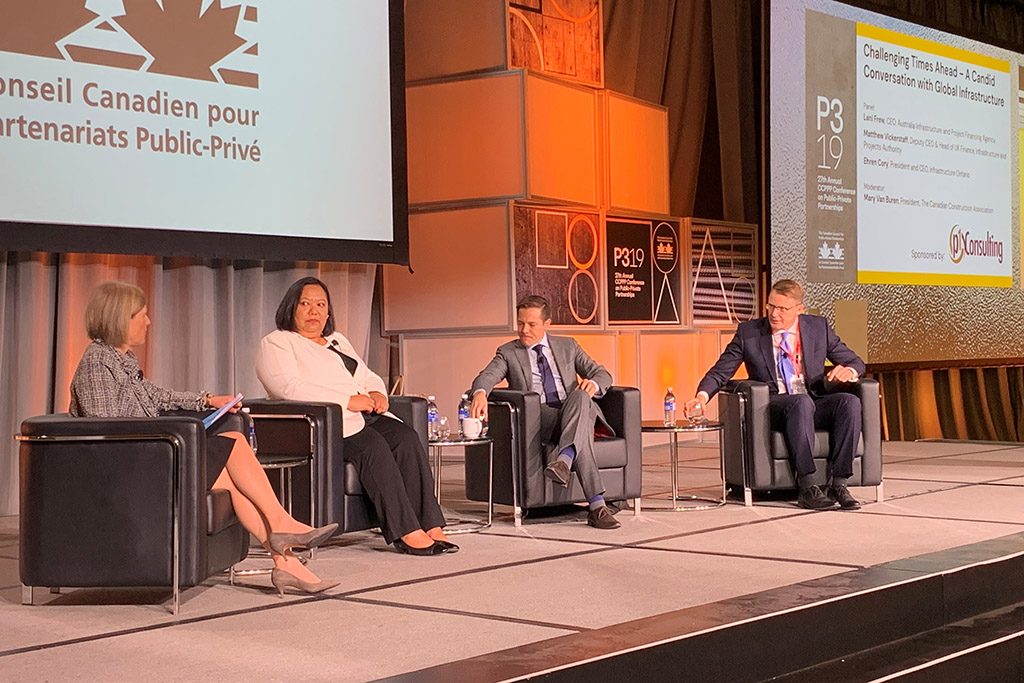TORONTO – P3s are facing new challenges and changes at an international level.
Canadian Construction Association president Mary Van Buren moderated a panel at the recent Canadian Council for Public-Private Partnerships (CCPPP) annual conference in Toronto where she spoke to representatives from several different government agencies about the role of public-private partnerships (P3) in addressing infrastructure challenges.
Lani Frew, CEO, Australia Infrastructure and Project Financing Agency CEO, UK Infrastructure and Projects Authority deputy CEO Matthew Vickerstaff and Infrastructure Ontario (IO) president and CEO Ehren Cory all contributed to the discussion.
“What they all have in common is that they want to do what’s best for the country and what’s best for their citizens and make that strong link between infrastructure investment, quality of life and quality of communities. Sometimes that gets lost when we talk about big picture (issues) like $180 million coming into Canada and then moving through the provinces down into communities,” Van Buren said.
“The challenges are pretty clear for all of our countries in that there’s a big appetite to build sustainable communities and to weather the storms coming up, but how do you go about it the most efficient way? Nobody has the silver bullet on it yet,” she added. “There’s lots of best practices we can learn from and we can keep innovating and trying new things.”
Vickerstaff said his organization’s purpose is to improve project delivery and look after major government projects ranging from high speed tube lines to nuclear submarines.
“Creating market confidence means talking to the private sector, and making sure to use data,” Vickerstaff said.
Cory said Infrastructure Ontario was created in the 1990s because provincial infrastructure was deteriorating and was dealing with the need to both tackle huge deficits while reinvigorating the infrastructure.
“Infrastructure was stalled in the late 1970s to the 1990s, it was deteriorating, and it didn’t have a clear path or public confidence. Now we do have the public license to invest in infrastructure and set long term goals,” he said. “There are challenging times ahead but it’s built on a successful foundation we created.”
Frew said the Australian government realized it needed to be an effective infrastructure partner and set up an agency to address their concerns.
“Over the last couple of years, we’ve worked with 10 government agencies with around $50 billion worth of infrastructure projects. Another goal we have is to invest significantly in the next 10 to 15 years to change shape and diversify the workforce,” Frew said.
Cory said while governments have changed during his tenure at IO, commitment to infrastructure has remained steady.
“There’s been government change at all three levels in the time I’ve been at IO, and commitment to infrastructure hasn’t changed during that time,” he said.
Van Buren noted infrastructure wasn’t a leading issue during the recent federal election and she said lack of awareness of the importance of construction and infrastructure extends to the current skills shortage.
“Governments all understand the economic benefit of investing in infrastructure and how it’s good for Canada but does the person on the street make that connection? I’m not sure, and that’s another mission we have, to reposition the image to become an employer of choice,” she said.
During the panel Cory pointed to other issues of concern to Canadians which are directly affected by infrastructure investment.
“People are concerned with transit, health care and these are all things affected by infrastructure. It’s not a debate because those issues are based on an understanding of long-term infrastructure investment,” Cory said.
Van Buren also raised innovation risk as a challenge for the construction industry, and asked the panel how the P3 model could improve innovation.
“Innovation is a tool to manage, and so is talking to market and maintaining our pipeline. Innovation is still maturing in our market, and we’re trying not to be too prescriptive in recent procurements and move to outcomes,” Cory said.
Frew said the Australian market is fragmented but “we are starting to come together.”
“We have similar challenges in that what do we mean when we talk about innovation? There’s technology, but also innovation around ideas and outcomes,” she said.











Recent Comments
comments for this post are closed